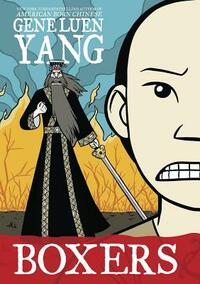Take a photo of a barcode or cover
In [b:Boxers|17210470|Boxers (Boxers & Saints, #1)|Gene Luen Yang|https://d.gr-assets.com/books/1359199413s/17210470.jpg|23691809], we see the origins of the Chinese Boxer rebellion through the eyes of Bao, who becomes one of its leaders. Bao grows up in rural China at the end of the 19th Century. He lives for the spring every year when travelling troups perform operas, full of drama, excitement and ancient stories of heroes and gods. The stories stay with him throughout the rest of the year when he performs his chores and is teased by his older brothers. His life changes irrevocably the day one of the foreign white men, one of their priests, come to the village and smashes the idol of the village's local earth god, Tu Di Gong. Bao's father and the village constable go to try to complain about the actions to the local magistrate, but never reach their destination. Along the way, they ran into a troop of foreign soldiers, who beat them badly and stole all their tribute to the magistrate. Bao's father survives, but is never the same. He spends his days staring out the window, mumbling inchoherently.
Years later, a travelling warrior named Red Lantern Chu arrives at the village, and starts training all the young men in the art of kung fu. Bao wants to train with the others, but is chased away by the jeers of his brothers and their friends. He trains in secret instead, aided by Red Lantern at night. Red Lantern is one of the disciples of the Big Sword Society. He wants the local young men to join with him in fighting the foreign influence in the country. As he leaves the village, taking the most promising recruits with him, including Bao's brothers, he sends Bao to be trained by ancient master on the top of a nearby mountain, who Bao calls Master Big Belly.
However, Red Lantern's mission did not go well. He was executed along with the other rebel leaders, and the village men were lucky to escape. Now imperial soldiers are looking for them. Bao, filled with the mystical fighting spirit of old gods, attacks the soldiers and rescues the men, making himself their de facto leader. The men take up Red Lantern's cause and travel the countryside, training any and all men who want to fight against the influence of "the foreign devils" in China. Soon the Society of the Righteous and Harmonius Fist, as Bao renames them, is picking up supporters in every village, and the rebellion is spreading. Of course, in the course of ridding the country of "foreign devils", they are also met with the "secondary devils", native Chinese who have converted to Christianity. Do they need to die too, to rid the empire of the foreign influence?
I have to admit, despite having a Masters degree in history, I knew next to nothing about the Boxer Rebellion, except what little was shown on Buffy the Vampire Slayer and Angel. My degree is focused on European mediaeval history, and there's so many interesting parts of world history that I wish I knew more about. So it's safe to say that almost everything I now know about the Boxer rebellion, I learned from these two graphic novels, which are both excellent.
Allowing us to see the rebellion from both sides is an excellent touch, and even when we understand the dissatisfaction of the Chinese peasants about the favour shown to the "foreign devils", white missionaries, diplomats and soldiers in China, as well as to the "secondary devils" who joined their cause. Being a peasant in a totalitarian regime is never fun, and it's understandable that too much mistreatment fosters rebellion and strife. It's still difficult to sympatise with Bao and the others as they cut down not only hostile imperial troops or thugs, but men, women and children who are peaceful, and just happen to be praying to a foreign god. After seeing the way Four-Girl/Vibiana is treated by her own family and relatives, it's not surprising that she seeks acceptance elsewhere and converts to get a chance at a different, and hopefully at least slightly better, life. It's also shown that while it may have been the thought of ample amounts of food that first drew her to other Christians, Vibiana grows devout in time, to the point where she is willing to die for her faith, if necessary.
The storytelling is magnificently done, and the art is brilliant. I haven't read [a:Gene Luen Yang|68959|Gene Luen Yang|https://d.gr-assets.com/authors/1265028960p2/68959.jpg]'s [b:American Born Chinese|118944|American Born Chinese|Gene Luen Yang|https://d.gr-assets.com/books/1317066615s/118944.jpg|114515] yet, but will absolutely be seeking it out after this. Boxers and Saints have won countless awards, well deservedly, and show that while a lot of people consider comic books and graphic novels as silly, shallow entertainment, truly profound and important stories can be told through the medium. Anyone interested in history, or just good stories, should check these books out.
Years later, a travelling warrior named Red Lantern Chu arrives at the village, and starts training all the young men in the art of kung fu. Bao wants to train with the others, but is chased away by the jeers of his brothers and their friends. He trains in secret instead, aided by Red Lantern at night. Red Lantern is one of the disciples of the Big Sword Society. He wants the local young men to join with him in fighting the foreign influence in the country. As he leaves the village, taking the most promising recruits with him, including Bao's brothers, he sends Bao to be trained by ancient master on the top of a nearby mountain, who Bao calls Master Big Belly.
However, Red Lantern's mission did not go well. He was executed along with the other rebel leaders, and the village men were lucky to escape. Now imperial soldiers are looking for them. Bao, filled with the mystical fighting spirit of old gods, attacks the soldiers and rescues the men, making himself their de facto leader. The men take up Red Lantern's cause and travel the countryside, training any and all men who want to fight against the influence of "the foreign devils" in China. Soon the Society of the Righteous and Harmonius Fist, as Bao renames them, is picking up supporters in every village, and the rebellion is spreading. Of course, in the course of ridding the country of "foreign devils", they are also met with the "secondary devils", native Chinese who have converted to Christianity. Do they need to die too, to rid the empire of the foreign influence?
I have to admit, despite having a Masters degree in history, I knew next to nothing about the Boxer Rebellion, except what little was shown on Buffy the Vampire Slayer and Angel. My degree is focused on European mediaeval history, and there's so many interesting parts of world history that I wish I knew more about. So it's safe to say that almost everything I now know about the Boxer rebellion, I learned from these two graphic novels, which are both excellent.
Allowing us to see the rebellion from both sides is an excellent touch, and even when we understand the dissatisfaction of the Chinese peasants about the favour shown to the "foreign devils", white missionaries, diplomats and soldiers in China, as well as to the "secondary devils" who joined their cause. Being a peasant in a totalitarian regime is never fun, and it's understandable that too much mistreatment fosters rebellion and strife. It's still difficult to sympatise with Bao and the others as they cut down not only hostile imperial troops or thugs, but men, women and children who are peaceful, and just happen to be praying to a foreign god. After seeing the way Four-Girl/Vibiana is treated by her own family and relatives, it's not surprising that she seeks acceptance elsewhere and converts to get a chance at a different, and hopefully at least slightly better, life. It's also shown that while it may have been the thought of ample amounts of food that first drew her to other Christians, Vibiana grows devout in time, to the point where she is willing to die for her faith, if necessary.
The storytelling is magnificently done, and the art is brilliant. I haven't read [a:Gene Luen Yang|68959|Gene Luen Yang|https://d.gr-assets.com/authors/1265028960p2/68959.jpg]'s [b:American Born Chinese|118944|American Born Chinese|Gene Luen Yang|https://d.gr-assets.com/books/1317066615s/118944.jpg|114515] yet, but will absolutely be seeking it out after this. Boxers and Saints have won countless awards, well deservedly, and show that while a lot of people consider comic books and graphic novels as silly, shallow entertainment, truly profound and important stories can be told through the medium. Anyone interested in history, or just good stories, should check these books out.
Exactly what I look for in a graphic novel. Beautiful, lyrical, connected to storytelling more than dreaming.
I really wanted to like these books better but I guess they just weren't for me. I found them kind of boring. To see just why they weren't for me, check out my full review on my blog!
I really enjoyed reading this. I didn't know much about the Boxer Rebellion going into this and I feel like I know more now (but I'm curious about it still; I'll probably do a little more research). I love Gene Luen Yang's style. It's both simple and artfully complicated. The colors and shapes of the opera gods was just stunning. I devoured this - a quarter of it on my morning break, half on my lunch, and finished it up in the afternoon. I do think I'll spend some time revisiting the illustrations, especially as I read through the second book, Saints.
I may come back to this once I read "Saints" as well but standing on its own it's a great story. The art is bright and colourful and the magical realism is seamless with this story of rebellion against Christian foreigners. I love how we track the passage of time and how the upbringing and situation of our main character reflects how he acts and what he believes. Must be read with "Saint" too, for sure. The two are just tied too close together.
I finished this in only a few hours. I really enjoyed the story and a piece of history that I hadn't known about. The art was beautiful. It's a good way for people who want to know more about Chinese history without having to read a big book on it. I only wish I knew a bit more ahead of time. I understand most of it, but I suppose that reading the companion book 'Saints' will help with that, which I'm planning on doing as soon as I can.
These two incredible graphic novels tell the story of the Boxer Rebellion in China in 1898. Boxers is told from the point of view of Little Bao, a young villager who has seen the foreign missionaries and soldiers take the ancient Chinese gods and beliefs and smash them apart. Trained in kung fu by a wandering man and also introduced to a ritual to bring the ancient gods to life, Little Bao becomes the leader of a band of commoners who become instrumental in the rebellion. Saints looks at the other side of the rebellion and is the story of Four-Girl, a daughter not even given a real name by her family. She finds a place for herself in Christianity, at first only attending the teachings because of the cookies but eventually finding a new name and new identity as Vibiana. Her faith makes her a target and both Vibiana and Little Bao have to find the extent of their beliefs and what they are willing to sacrifice for them. There are no easy answers here, no right and wrong, there are only choices in the middle of violence.
Yang has created two books that must be read together to get a full picture of the history. Both books are one-sided, showing only the point of view of the rebels or the Christians. At the same time, they are both balanced against one another, showing the violence on both sides, the hubris, and the faith. They also both capture a young individual caught up in history and questioning their own choices.
As always, Yang has written a compelling book. His art is strong and his story arcs are well developed. I found Boxers to be the more interesting of the two with the Chinese gods and the question of being in control of that amount of violence. Saints to me is a necessary foil to Boxers but lacks its depth. That said, Boxers is one of the more compelling graphic novels I have read for tweens, so Saints had a lot to live up to.
Highly recommended, this graphic novel duo has a place in every library collection. Its violence and questions about faith, duty and responsibility make it a good choice for teens and tweens. Appropriate for ages 12-15.
Yang has created two books that must be read together to get a full picture of the history. Both books are one-sided, showing only the point of view of the rebels or the Christians. At the same time, they are both balanced against one another, showing the violence on both sides, the hubris, and the faith. They also both capture a young individual caught up in history and questioning their own choices.
As always, Yang has written a compelling book. His art is strong and his story arcs are well developed. I found Boxers to be the more interesting of the two with the Chinese gods and the question of being in control of that amount of violence. Saints to me is a necessary foil to Boxers but lacks its depth. That said, Boxers is one of the more compelling graphic novels I have read for tweens, so Saints had a lot to live up to.
Highly recommended, this graphic novel duo has a place in every library collection. Its violence and questions about faith, duty and responsibility make it a good choice for teens and tweens. Appropriate for ages 12-15.




